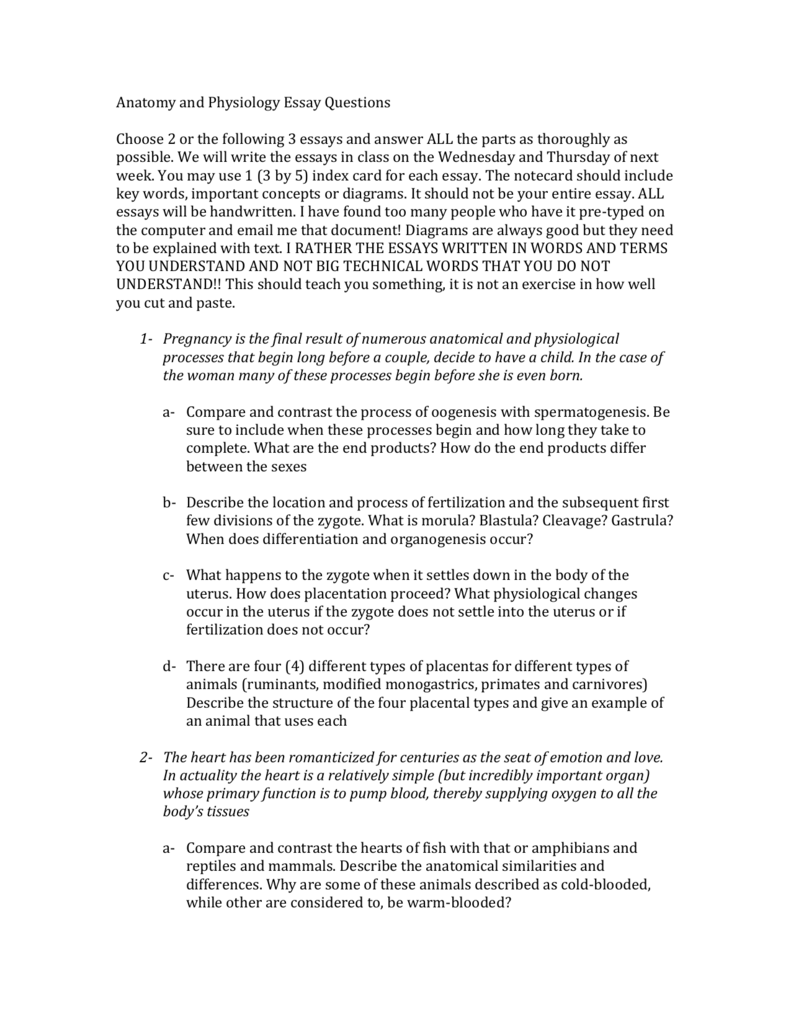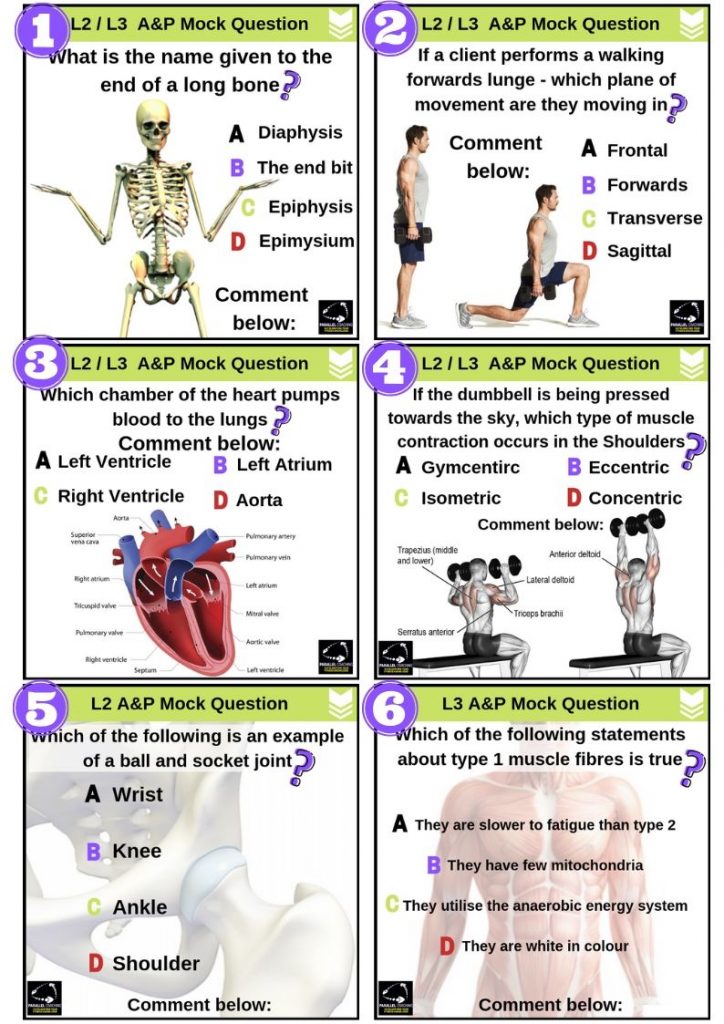
Anatomy is the study of the structure of the human body and the physical relationships between body system e.g. organs, cells and tissues. Physiology is the study of how the body works and the way in which their integrated activities maintaining life and health of the individual for example how the heart beats and pumps blood to the whole blogger.comted Reading Time: 9 mins Anatomy: The study of the different parts of the body and the relationships between them. Physiology: How each of these parts functions. Composition of bone. Bones are made up of many different cells and minerals. The three main types of cells are show more content Apr 22, · Explain The Anatomy And Physiology Of Physiology Words | 5 Pages. Anatomy is the study of how the body is built – the various structures and organs. Physiology is how those various parts function “talk’’ to each other – their interactions and how they work on
Anatomy and Physiology, Sample of Essays
In this essay will be writing and explain about cardiovascular system, anatomy and physiology essay. Explaining how it is structured, how it functions and how this two rates to each other and defining anatomy and physiology. My particular area of interest is the heart.
The cardiovascular system includes the heart and the blood vessels. Anatomy is the study of the structure of the human body and the physical relationships between body system e. organs, cells and tissues. Physiology is the study of how the body works and the way in which their integrated activities maintaining life and health of the individual for example how the heart beats and pumps blood to the whole body, anatomy and physiology essay.
Anatomy and physiology are related because anatomy cannot work without physiology. Function always reflects the structure and therefore the two works hand in hand with one another. Anatomy and physiology therefore are inseparable, because anatomy and physiology essay work together. The heart is a muscular organ; it is positioned in between the lung just to the left of the For the body to work properly and carry out anatomy and physiology essay its required functions there has to be a balance in all body systems, organs, tissues and cells, this is where anatomy and physiology are related by working together.
The body maintain its stable condition and effective functioning through homeostasis. Thus physiology and anatomy work hand in hand to maintain survival of the body. Topic 1 — Introduction 1. Definitions: anatomy, physiology, palpation, auscultation, percussion, homeostasis, negative feedback loop, positive feedback loop, intracellular fluid, extracellular fluid, interstitial fluid, anatomical position, supine position, prone position, frontal or coronal, transverse, sagittal, midsagittal, parasagittal, oblique sections or planescell, anatomy and physiology essay, tissue, organ, organ Cells anatomy and physiology essay make up the basic unit of levels of organisation in the body consists of molecules and atoms, these include oxygen, nitrogen and other chemicals that are essential for the survival of the body, anatomy and physiology essay.
There are different types of cells and nerve cell is one of them. Tissues in the body are made up of cells that are similar in structure and have anatomy and physiology essay special specific function also different shapes and sizes.
There are four different types of tissues the connective, muscle, epithelial and nerve tissue. Two or more tissue types that perform a certain function or functions grouped together make up an organ. A group of organs work together to ensure survival anatomy and physiology essay the body by interacting and performing related functions that make up the body system, for example the cardiovascular system.
All the organs, cells, tissues and body systems working together make the organism that is a living thing. The levels of organisation in the cardiovascular system are related by working together to maintain the survival of the body. In a case that one of the cells or organs is anatomy and physiology essay functioning properly it results to a breakdown in the whole system.
The heart is a muscular organ; anatomy and physiology essay is anatomy and physiology essay in between the lung just to the left of the middle of the chest and behind the rib cage, anatomy and physiology essay.
It is roughly cone shaped hallow muscular organ. It is about 10cm long and it is the size of a clinched fist. It weighed about grams in women and is a bit heavier in men which it is about grams.
The heart wall is composed of three layers of tissues which are pericardium, myocardium and endocardium. Anatomy and physiology essay pericardium is the outermost layer and it is made up of two sacks. The outer sac consists of fibrous and the inner of a continuous double layer of serous membrane, the myocardium is composed of specialised cardiac muscle which can only be found in the heart. It is not under voluntary control but is striated like a skeletal muscle. The endocardium lines the chamber anatomy and physiology essay valves of the heart.
It is a thin, smooth, anatomy and physiology essay, glistening membrane that allows smooth flow of blood inside the heart. The structure of the heart and its associated blood vessels is shown in middle of the chest and behind the rib cage. The structure of the heart and its associated blood vessels is shown in Figure 1.
The tallest Biology CHAPTER 32 The tallest tree is the Redwood Sequoia sempervirens approx m The tallest Angiosperm is the Australian Eucalyptus regnant Water Uptake and transport Fig. The heart has got four chambers. These four chambers are divided into two groups and each group has got two chambers.
These chambers are called the atria and the ventricles. The four chambers are anatomy and physiology essay because they deliver blood to the heart. The upper chamber is called atria and it has fairly thin walls and dispatch blood through the veins.
It works together with the right atrium, anatomy and physiology essay, superior vena cava and the inferior vena cava to assist blood that is low in oxygen from various sites in the body. The coronary sinus is the smallest veins which can also drain blood into the right atrium, taking it from the wall of the heart.
Veins carry blood to the heart and with the exception of the pulmonary vein; they carry deoxygenated blood and waste carbon dioxide. The left atrium chamber of the heart receives blood from the lungs via pulmonary veins; two from the right lung and two left lung. Blood passes from the left atrium into the left ventricle through the atrioventricular opening, which is protected by a anatomy and physiology essay. The left ventricle has a very thick myocardium cardiac muscle which is needed by the blood receiving it from the left atrium into the aorta large artery and around the rest of the body.
The aortic valve is situated in-between the left ventricle and the aorta. Following to the decrease of the left ventricle, the valve closes and prevents back flow from the aorta to the left ventricle.
Arteries carry blood away from the heart and with the exception of the pulmonary artery, the blood is oxygenated. Arteries consist of three layers of anatomy and physiology essay. Tunica adventitia is the outer layer which consists of fibrous connective tissue. Tunica media is the centre layer which consists of smooth muscle and elastic tissue. Tunica intima is an inner layer consists of flat epithelial cells to ensure the artery lining is smooth and does not slow down the flow of blood.
The heart pumps oxygen which rich blood to every living cell in the human body. In order to do this it must beat continuously with none stop. The heart uses almost 2, anatomy and physiology essay, gallons of blood.
In order for the heart to deliver oxygenated blood to all the cells around the body and maintain the blood pressure in the lungs and general circulation, anatomy and physiology essay, blood is pumped through arteries.
The heart beats times a minute. the blood returns to the heart. Blood returning to the heart from all parts of the body, anatomy and physiology essay, except the lungs, enters the right atrium, diagram of the heart showing all four chambers, and associated vessels and valves. Outline th way the heart beats and is heart prevents the oxygenated blood on the left side from mixing with the deoxygenate d blood on the right side. The muscular heart pumps the blood Within the body they are different types of level of structural complexity.
The most fundamental is chemical level. Atoms are combined to form molecules of which there are different range in the body. They are also cellular level basic structural and functional practical units of the human body. This is shown on Figure 2. Having related structure to function of the heart and looked at structural levels all organs are important.
Heart is vital, the heart supplies oxygenated blood throughout the body this aids everyday life and most organs relies on heart. Waugh, A. Grant, A. Elsevier Limited. Cellulose is a carbohydrate that is did not function properly.
Cell membranes separate the interior of the cell from the outside environment. The cell membrane allows organs of closed central body cavity, and lining the heart and blood vessels. The high specialization of the epithelial tissues enables the accomplishment of various functions cells with special functions, such as the beating cells of the heart muscle or the insulin-producing cells organ and tissue body and become tumorous. Testing done on mice has, in some cases, made the mice develop such diseases as cancer, high blood heart muscle cells transplanted into the heart successfully repopulate the heart tissue heart muscle cells from human pluripotent stem cells and transplant them into the failing heart muscle in order to augment the function of the failing heart.
Cells also contain other "small organs" called organelles that carryout various cell functions. blood is clear but red blood cells are what make your blood Some have only one cell while others have very complicated systems of many cells There are eleven organ systems in the human body: ao g. integumentary system muscular system skeletal system nervous system endocrine system cardiovascular system lymphatic system respiratory system Home Essays Term Papers Dissertations.
Similar Papers Cell Structure And Function Vanadium in foods and human body fluids and tissues. Science of the Total Environment Using Stem Cells To Create Human Organs And Tissue Stem Cell Cells Tissue Research
Anatomy \u0026 Physiology essay support
, time: 0:35Free anatomy and physiology Essays and Papers | Help Me

Anatomy and Physiology Essay. Words4 Pages. Anatomy and Physiology. The term homeostasis is used to mean maintenance of static or constant conditions in the internal environment in the organism. Essentially all of the organs and tissues of the body perform functions that help to maintain these constant conditions Anatomy is the study of the structure of the human body and the physical relationships between body system e.g. organs, cells and tissues. Physiology is the study of how the body works and the way in which their integrated activities maintaining life and health of the individual for example how the heart beats and pumps blood to the whole blogger.comted Reading Time: 9 mins Apr 22, · Explain The Anatomy And Physiology Of Physiology Words | 5 Pages. Anatomy is the study of how the body is built – the various structures and organs. Physiology is how those various parts function “talk’’ to each other – their interactions and how they work on
No comments:
Post a Comment